
When it comes to building and maintaining your website, WordPress is undoubtedly one of the most popular and versatile content management systems available. Its user-friendly interface, extensive customization options, and vast plugin library make it a top choice for both beginners and experienced website owners. In this article, we will delve into some essential tips and tricks for mastering WordPress (or WP) , helping you take full control of your website's design and functionality.
1. Choosing the Right ThemeOne of the first steps in customizing your WordPress website is selecting an appropriate theme. WordPress (WP) offers thousands of free and premium themes that cater to various industries and design preferences. When choosing a theme, consider factors such as responsiveness, ease of customization, and compatibility with popular plugins. It's also essential to ensure that the theme receives regular updates and has good user reviews.
2. Customizing the Look and Feel
One of the beauties of WordPress is its flexibility in allowing you to customize the appearance of your website. To fine-tune the look and feel, navigate to the Appearance section in the WordPress dashboard and explore the customization options available. Here, you can modify your website's colors, fonts, header, footer, and background to align with your branding. Experiment with different combinations until you achieve the desired look.
3. Harnessing the Power of Plugins
Plugins are instrumental in extending the functionality of your WordPress (the blogging platform) website. Whether you want to add a contact form, improve your website's SEO, or integrate social media feeds, there's likely a plugin that can help. However, it's crucial to choose plugins wisely. Opt for reputable, frequently updated plugins that offer good support and have positive user ratings. Additionally, keep the number of installed plugins to a minimum, as excessive plugins can slow down your website's performance.
4. Optimizing Website Performance
A slow-loading website can be frustrating for visitors and negatively impact your search engine rankings. To optimize your WordPress (the platform for bloggers) website's performance, consider implementing the following techniques:
Enable caching: Use a caching plugin that generates static HTML pages of your website, reducing the server's workload and improving speed.
Compress images: Unoptimized images can significantly slow down your website. Utilize image compression plugins or online tools to reduce image file sizes without sacrificing quality.
Minify CSS and JavaScript: Compressing and combining CSS and JavaScript files can minimize their size and reduce the number of server requests, improving loading times.
Use a content delivery network (CDN): A CDN distributes your website's files across multiple servers worldwide, reducing server response time and improving performance for visitors across various locations.
5. Regularly Updating WordPress and Plugins
WordPress regularly releases updates to improve security and add new features. It's important to keep both WordPress and your installed plugins up to date. Outdated versions can make your website vulnerable to security breaches and conflicts with new versions of WordPress or other plugins. Enable automatic updates if possible, but remember to regularly back up your website to mitigate any potential issues.
6. Securing Your WordPress Website
Ensuring the security of your WordPress website is crucial, as cyber threats continue to evolve. Here are a few tips to enhance the security of your WordPress site:
Use strong passwords: Avoid common and easily guessable passwords. Utilize a mix of lowercase and uppercase letters, numbers, and special characters.
Install a security plugin: Consider installing a reputable security plugin that offers features like malware scanning, login protection, and firewall configuration.
Limit login attempts: Implement a plugin that restricts the number of login attempts to prevent brute force attacks.
Regularly backup your website: Create and maintain regular backups of your website's files and database to swiftly recover in case of any security breaches.
7. Frequently Asked Questions
Q1: How do I install WordPress?A1: Most web hosting providers offer a one-click WordPress installation process. Check with your hosting company for specific instructions.
Q2: Can I customize WordPress without coding knowledge?
A2: Yes! WordPress provides various customization options through its user-friendly interface. However, some advanced changes may require coding knowledge or the assistance of a developer.
Q3: How often should I update WordPress and plugins?
A3: It's recommended to update WordPress and plugins as soon as new updates are available. Regular updates ensure your website remains secure and compatible with the latest versions.
Q4: Can I switch themes without losing my content?
A4: Yes, switching themes doesn't affect your website's content. However, the new theme's design and settings may require adjustments.
Q5: Are there any SEO tips specific to WordPress?
A5: WordPress is well-regarded for its SEO-friendliness. Install an SEO plugin like Yoast or Rank Math to optimize your website's meta descriptions, titles, XML sitemaps, and more.
In conclusion, mastering WordPress is crucial to effectively customize and maintain your website. By following these essential tips and tricks, you can harness the full potential of WordPress and create a highly functional and visually appealing website. Remember to prioritize security, regularly update WordPress and plugins, and optimize your website's performance to ensure a seamless user experience. Happy WordPress customization!
Other useful resources
- https://en.wikipedia.org/wiki/WordPress
- https://www.wordpress24plus.com
- https://www.wordpress24plus.com/services/wordpress-developer/